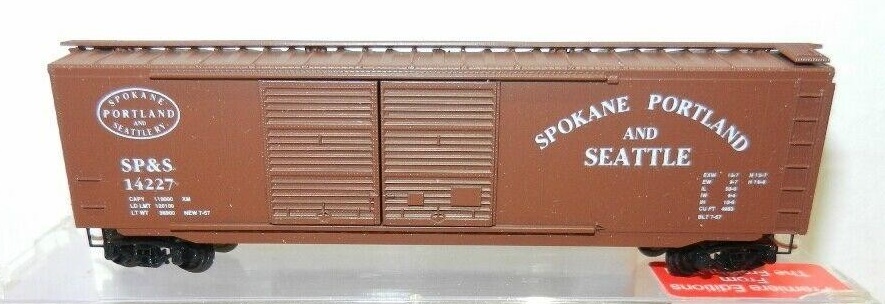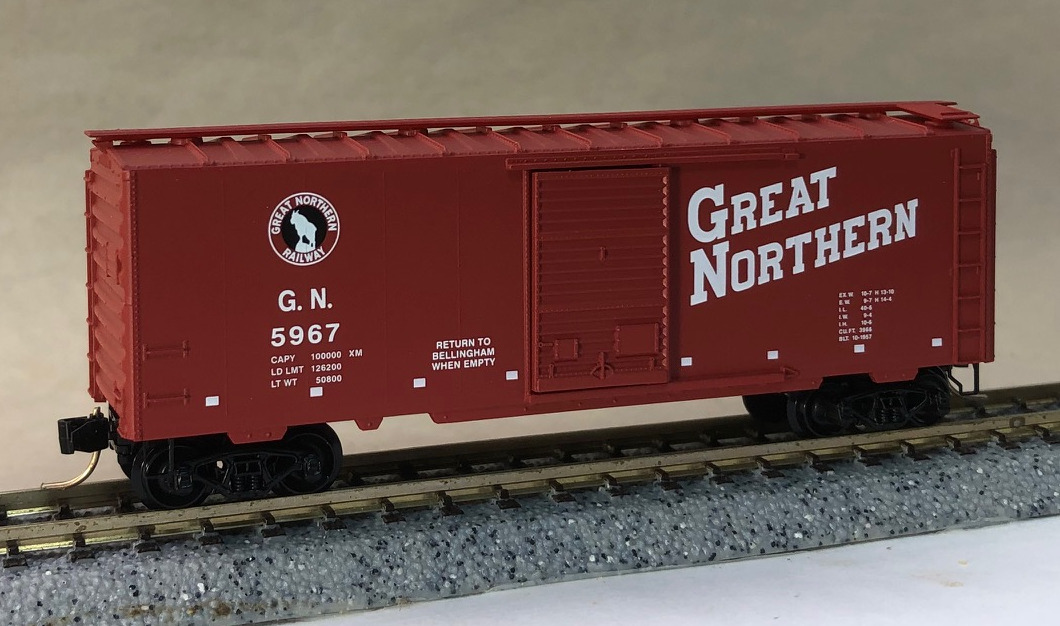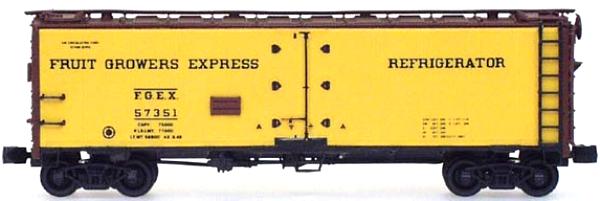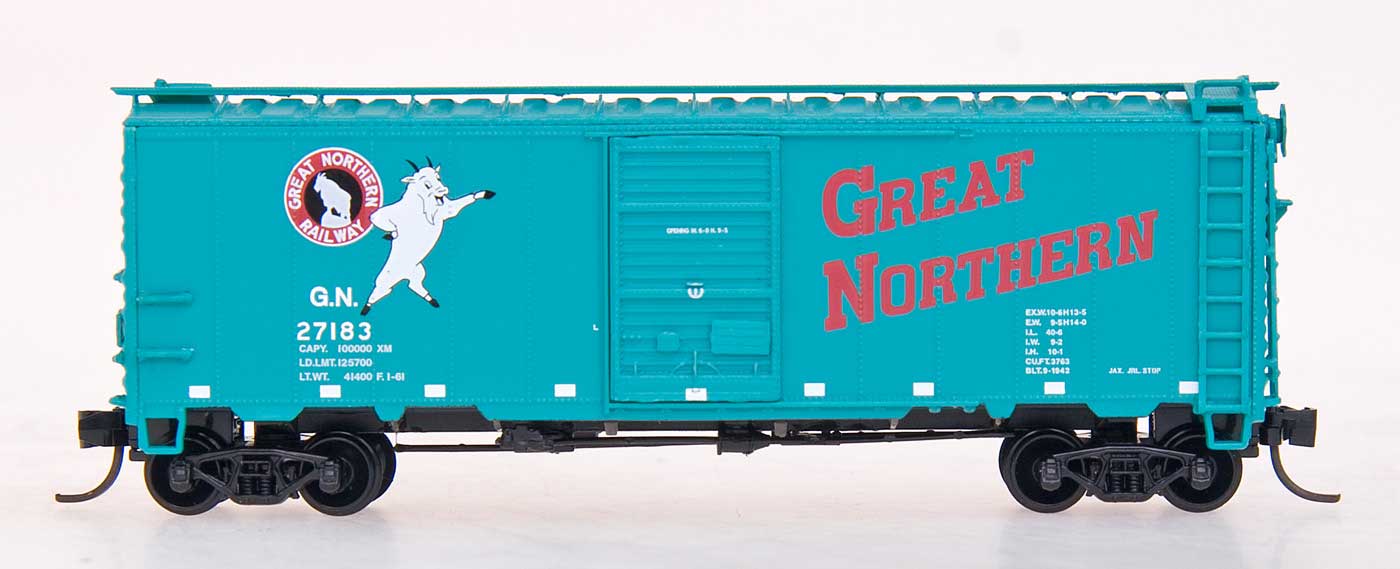Model Information: Although not specifically marketed as such, this body style has been used to model 50 foot PS-1 Boxcars.
Prototype History: The 50-foot boxcar made its first appearance in the 1930s and steadily grew in popularity over the years, which further improved redundancies by allowing for even more space within a given car. Today, the 50-footer remains the common boxcar size. After the second world war ended, and steel became once again readily available, steel became the go-to choice for construction of boxcars. Pullman Standard and ACF were some of the most prolific builders of these cars.
Double Doors were frequently an option for most of the major North American railcar manufacturers in the 1950s, 1960s and 1970s. These cars were slightly more expensive to produce and maintain, but for many applications allowed faster loading and unloading times.
Double Doors were frequently an option for most of the major North American railcar manufacturers in the 1950s, 1960s and 1970s. These cars were slightly more expensive to produce and maintain, but for many applications allowed faster loading and unloading times.
Road Name History: 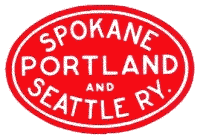 The Spokane, Portland & Seattle Railway (SP&S) (reporting mark SPS) was a United States-based railroad incorporated in 1905. It was a joint venture by the Great Northern Railway and the Northern Pacific Railway to build a railroad along the north bank of the Columbia River. Remnants of the line are currently operated by BNSF Railway.
The Spokane, Portland & Seattle Railway (SP&S) (reporting mark SPS) was a United States-based railroad incorporated in 1905. It was a joint venture by the Great Northern Railway and the Northern Pacific Railway to build a railroad along the north bank of the Columbia River. Remnants of the line are currently operated by BNSF Railway.
The railroad was chartered in 1905 by James J. Hill to connect the two transcontinental railroads owned by him, the Northern Pacific (NP) and Great Northern (GN), to Portland, Oregon from Spokane, Washington, to gain a portion of the lumber trade in Oregon, a business then dominated by E.H. Harriman's Union Pacific and Southern Pacific railroads. Construction began in 1906 under the name Portland & Seattle Railway, proceeding eastward from Vancouver, Washington. 1906 also saw the start of construction of the line between Vancouver and Portland, including work on three major new bridges, crossing the Columbia River, the Oregon Slough and the Willamette River. The northernmost of these was the first bridge of any kind to be built across the lower Columbia River.
In January 1908 "Spokane" was added to the railroad's name, making it the Spokane, Portland & Seattle Railway. SP&S freight and passenger service (from Pasco) to Portland was inaugurated in November 1908. By 1909 the railroad had completed construction of its line up to Spokane along the Snake River. In 1910 SP&S gained control of the Oregon Electric interurban railway, which the Great Northern had acquired two years before. Under the control of the SP&S the railroad was extended southward to Eugene, Oregon by 1912. SP&S also operated a second subsidiary railroad in western Oregon, the Oregon Traction Company, which owned a route to Seaside, Oregon. A third route on which the SP&S operated extended southward from Wishram, Washington to Bend, Oregon was the Oregon Trunk Railroad.
Read more on Wikipedia and The Spokane Portland and Seattle Railway Historical Society

The railroad was chartered in 1905 by James J. Hill to connect the two transcontinental railroads owned by him, the Northern Pacific (NP) and Great Northern (GN), to Portland, Oregon from Spokane, Washington, to gain a portion of the lumber trade in Oregon, a business then dominated by E.H. Harriman's Union Pacific and Southern Pacific railroads. Construction began in 1906 under the name Portland & Seattle Railway, proceeding eastward from Vancouver, Washington. 1906 also saw the start of construction of the line between Vancouver and Portland, including work on three major new bridges, crossing the Columbia River, the Oregon Slough and the Willamette River. The northernmost of these was the first bridge of any kind to be built across the lower Columbia River.
In January 1908 "Spokane" was added to the railroad's name, making it the Spokane, Portland & Seattle Railway. SP&S freight and passenger service (from Pasco) to Portland was inaugurated in November 1908. By 1909 the railroad had completed construction of its line up to Spokane along the Snake River. In 1910 SP&S gained control of the Oregon Electric interurban railway, which the Great Northern had acquired two years before. Under the control of the SP&S the railroad was extended southward to Eugene, Oregon by 1912. SP&S also operated a second subsidiary railroad in western Oregon, the Oregon Traction Company, which owned a route to Seaside, Oregon. A third route on which the SP&S operated extended southward from Wishram, Washington to Bend, Oregon was the Oregon Trunk Railroad.
Read more on Wikipedia and The Spokane Portland and Seattle Railway Historical Society
Brand/Importer Information: The Freight Yard was a hobby shop that did custom decoration and special runs of other manufacturers' N Scale products. It sold its custom products under several brands or collections: Premiere Editions, by The Freight Yard and Dreams Design.
It was located in Anaheim, California and then moved to 2006 in Phoenix, Arizona.
Established in the late 1980s, it stopped business under this name by the end of the 2000s.
The Freight Yard was owned and operated by Darren J. Cohen. Darren is now operating North Valley Trains.
The Freight Yard / Premiere Editions runs are usually available in series of two to twelve different numbers (suffixed A to M, with I not used).
The first two digits of the stock number correspond to the release year (9x being 199x, and 2x being 200x).
It was located in Anaheim, California and then moved to 2006 in Phoenix, Arizona.
Established in the late 1980s, it stopped business under this name by the end of the 2000s.
The Freight Yard was owned and operated by Darren J. Cohen. Darren is now operating North Valley Trains.
The Freight Yard / Premiere Editions runs are usually available in series of two to twelve different numbers (suffixed A to M, with I not used).
The first two digits of the stock number correspond to the release year (9x being 199x, and 2x being 200x).
Manufacturer Information:  Micro-Trains Line split off from Kadee Quality Products in 1990. Kadee Quality Products originally got involved in N-Scale by producing a scaled-down version of their successful HO Magne-Matic knuckle coupler system. This coupler was superior to the ubiquitous 'Rapido' style coupler due to two primary factors: superior realistic appearance and the ability to automatically uncouple when stopped over a magnet embedded in a section of track. The success of these couplers in N-Scale quickly translated to the production of trucks, wheels and in 1972 a release of ready-to-run box cars.
Micro-Trains Line split off from Kadee Quality Products in 1990. Kadee Quality Products originally got involved in N-Scale by producing a scaled-down version of their successful HO Magne-Matic knuckle coupler system. This coupler was superior to the ubiquitous 'Rapido' style coupler due to two primary factors: superior realistic appearance and the ability to automatically uncouple when stopped over a magnet embedded in a section of track. The success of these couplers in N-Scale quickly translated to the production of trucks, wheels and in 1972 a release of ready-to-run box cars.
Micro-Trains Line Co. split off from Kadee in 1990 to form a completely independent company. For this reason, products from this company can appear with labels from both enterprises. Due to the nature of production idiosyncrasies and various random factors, the rolling stock from Micro-Trains can have all sorts of interesting variations in both their packaging as well as the products themselves. When acquiring an MTL product it is very important to understand these important production variations that can greatly enhance (or decrease) the value of your purchase.
Please consult our Micro-Trains Collector's Guide

Micro-Trains Line Co. split off from Kadee in 1990 to form a completely independent company. For this reason, products from this company can appear with labels from both enterprises. Due to the nature of production idiosyncrasies and various random factors, the rolling stock from Micro-Trains can have all sorts of interesting variations in both their packaging as well as the products themselves. When acquiring an MTL product it is very important to understand these important production variations that can greatly enhance (or decrease) the value of your purchase.
Please consult our Micro-Trains Collector's Guide
Item created by: Alain LM on 2022-04-14 03:17:47. Last edited by Alain LM on 2022-09-18 07:07:30
If you see errors or missing data in this entry, please feel free to log in and edit it. Anyone with a Gmail account can log in instantly.
If you see errors or missing data in this entry, please feel free to log in and edit it. Anyone with a Gmail account can log in instantly.


